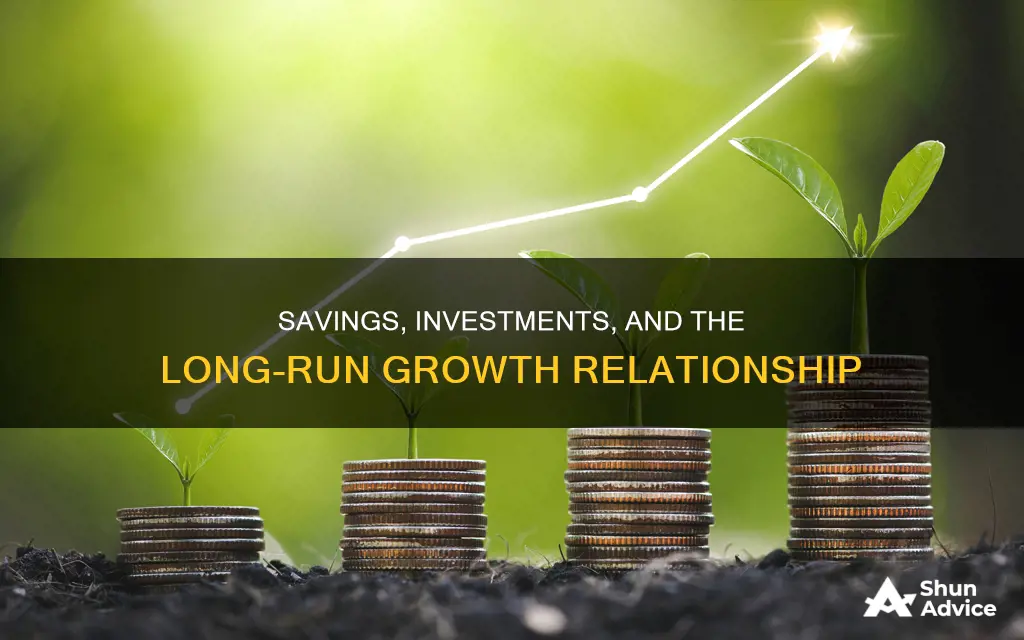
Saving and investing are important concepts in economics, and they are often used interchangeably, but there is a difference. Saving is setting aside money for future use, while investing is buying assets such as stocks, bonds, or real estate to make a profit. These concepts are related to long-run growth because they can increase an economy's capacity to produce more. An increase in savings allows banks to lend more money to firms for investment, which boosts productivity and economic growth over time. This relationship between savings and investment is crucial for a country's economic development, as it determines its ability to produce and grow in the future.
What You'll Learn

Savings ratio and economic activity
Consumer spending constitutes a large proportion of a country's GDP, and when consumers save more, their spending decreases, which can lead to a fall in economic activity. This was evident during the 2008/2009 recession, where a rapid increase in savings and a subsequent decline in consumer spending contributed to the economic downturn. In such situations, a slight decrease in the savings rate and a corresponding rise in consumer spending can help stimulate the economy and promote recovery.
However, in the long run, higher savings can contribute to economic growth by financing higher levels of investment and boosting productivity. Savings provide the funds necessary for investments, and an increase in savings can lead to increased investment in physical capital, resulting in a higher productive capacity for the economy. This is particularly relevant for firms, as they can utilise these savings to invest in technology and equipment to lower their production costs and increase output.
Additionally, government policies that encourage savings can also lead to higher economic growth. These policies may include tax incentives on savings or investments, infrastructure development, and initiatives that promote technological advancements.
It is worth noting that the relationship between savings, investment, and economic growth is complex and subject to various factors, including market volatility, interest rates, and economic outlook. While savings can facilitate investment and long-run growth, a sudden increase in savings may not immediately translate to higher investment during periods of economic pessimism or recession. Therefore, a balance between savings and consumer spending is crucial to maintain economic stability and promote long-term growth.
Retirement Planning: Why Investing is a Must, Not a Maybe
You may want to see also

Investment and long-term growth
Firstly, investment adds to the stock of physical capital in an economy. Savings facilitate investment by providing the necessary funds. When individuals save, they deposit their money in banks, which can then lend these funds to firms for investment purposes. This investment allows firms to expand their production capacity, leading to increased output over the long run. For example, firms can invest in new technologies or equipment that enhance their efficiency and productivity.
Secondly, investment is crucial for technological progress. By investing in research and development, firms can develop and adopt new technologies that improve their production processes. Technological advancements increase productivity, enabling the economy to produce more with the same or fewer inputs. Government policies, such as tax credits for research and development, can further encourage such investments.
Lastly, investment in human capital, including education and health, improves the quality of labour in the economy. A more educated and skilled workforce is more productive, contributing to long-term economic growth. Again, government policies can play a role in promoting human capital accumulation, such as through incentives for higher education or investments in the healthcare system.
It is important to note that the relationship between savings, investment, and long-term growth is complex. While savings can facilitate investment, a sharp increase in savings may lead to a decrease in consumer spending, potentially causing a recession. Therefore, a balance between consumption and investment is necessary for sustainable long-term economic growth.
In summary, investment plays a pivotal role in driving long-term economic growth. It increases the capacity to produce by expanding physical capital, enhancing technology, and improving human capital. Savings contribute to investment by providing the financial resources needed for firms to expand and innovate. However, the relationship between savings and investment is nuanced, and a healthy balance between consumption and investment is essential for long-term economic prosperity.
Investing: Is It Right for Your Money?
You may want to see also

Short-term savings and consumer spending
Short-term savings are typically achieved within a window of six months to five years. They are more specific and have defined deadlines, such as vacations, large purchases, or recurring payments. On the other hand, long-term goals are usually achieved after five years or more and may include retirement planning and paying off mortgages.
When it comes to short-term savings, it is essential to have a realistic and attainable plan. This may involve creating a monthly budget, where a certain amount from your income is set aside for savings. For instance, if you want to save $3600 for a down payment on a car in a year, you will need to save $300 each month. A helpful tip is to transfer the money into savings as soon as you get your paycheck, so you are not tempted to spend it.
There are various savings accounts that are well-suited for short-term goals, including high-yield savings accounts, money market accounts, and certificates of deposit (CDs). High-yield savings accounts offer higher interest rates, allowing your savings to grow faster. Money market accounts provide higher interest rates than traditional savings accounts and easy access to your funds. CDs are a good option for individual goals as they have a set maturity date that can be aligned with your savings target. For instance, if you are planning a vacation in a year, you can consider a 1-year CD.
While saving for short-term goals, it is also beneficial to cut back on expenses. This could involve cooking at home instead of dining out, cancelling unused subscription services, or reducing utility costs by being mindful of your thermostat settings and unplugging appliances when not in use.
Additionally, you can boost your savings by selling unwanted items online. Various online marketplaces offer opportunities to sell items such as old clothes, records, or used technology.
It is important to note that while saving is essential, it should not come at the expense of consumer spending, which is a significant driver of economic activity. A rapid increase in savings coupled with a decrease in consumer spending can lead to a recession, as witnessed during the 2008/2009 economic crisis. Therefore, a balance between savings and consumer spending is crucial for economic growth.
Philip Morris: A Risky Investment Gamble?
You may want to see also

Long-term investing and market volatility
Saving and investment are closely related to long-run growth. An increase in savings can help finance higher levels of investment and boost productivity over the long term. In economics, the level of savings is said to equal the level of investment, as investment needs to be financed by saving. If people save more, banks can lend more to firms for investment.
However, there is a paradox: while savings are generally considered good and virtuous, if everyone saves at once, it can cause a drop in aggregate demand and lead to a recession. This is known as the Paradox of Thrift.
Now, let's turn our attention to long-term investing and market volatility:
Market volatility is a normal and inevitable feature of long-term investing. It refers to the frequency and magnitude of price movements, either up or down. The bigger and more frequent the price swings, the more volatile the market is. While volatility can be unnerving, it may also present opportunities for growth.
- Volatility is typical: Understand that market volatility is a standard part of investing. It is the price you pay when investing in assets that offer the best chance of reaching your long-term goals.
- Long-term perspective: Investing is a long-haul game. A well-balanced, diversified portfolio is designed with periods of volatility in mind. Remember that volatility is part of the journey towards significant growth.
- Embrace volatility: Instead of panicking during volatile periods, consider them opportunities. Volatility can allow you to purchase stocks at discounted prices, potentially leading to substantial gains when the market rebounds.
- Stay the course: Long-term investors are generally advised to ignore short-term volatility and maintain their investment strategy. Over the long run, stock markets tend to rise, and giving in to fear or greed can undermine your long-term plan.
- Hedging strategies: Consider using hedging strategies to navigate volatility, such as buying protective puts to limit potential losses without selling shares. However, note that options like these become pricier during volatile periods.
- Emergency fund: Maintain a healthy emergency fund to avoid the need to liquidate investments during volatile periods. This will provide peace of mind and ensure you don't have to sell assets in a down market.
- Rebalance your portfolio: Volatility can cause sharp changes in investment values, potentially drifting your asset allocation away from your desired divisions. Periodically rebalance your portfolio to align it with your investing goals and risk tolerance.
- Volatility as an opportunity: Volatile markets can provide opportunities for day traders to enter and exit positions. Additionally, volatility is a crucial component in options pricing and trading.
- Measuring volatility: Volatility is typically measured using standard deviation or variance of returns over a specific period. The higher the standard deviation, the more a portfolio is likely to fluctuate.
- Volatility and risk: Higher volatility often indicates higher risk. Volatile assets are generally considered riskier as their prices are less predictable and can experience dramatic swings.
In conclusion, while market volatility can be intimidating, it is an inherent part of long-term investing. By understanding and embracing volatility, investors can make informed decisions, take advantage of opportunities, and work towards their long-term financial goals.
Ammeri Sports: Who Invests?
You may want to see also

Savings and investment funds
The importance of savings and investment funds is highlighted by the fact that consumer spending accounts for 63% of GDP. A rise in the savings ratio can have a significant impact on economic activity. Higher savings can help finance higher levels of investment and boost productivity in the long term. The Harrod-Domar model of economic growth suggests that the level of savings is a key factor in determining economic growth rates. Savings and investment funds are also linked to the accumulation of capital, which is a key driver of economic growth. An increase in savings leads to more investment in capital, which in turn, leads to higher economic growth.
In the short term, a rapid increase in savings could lead to a fall in consumer spending, which may cause a recession. However, in the long term, savings are crucial for investment and economic growth. This is because investment needs to be financed by savings. When individuals save more, banks are able to lend more money to firms for investment purposes.
There are various types of savings and investment funds, which differ in terms of risk and potential returns. Lower-risk funds, such as high-yield savings accounts, offer predictable but smaller growth. These are less risky because the money is not invested in the stock market and is easily accessible. On the other hand, higher-risk funds, such as stocks and long-maturity bonds, offer the potential for rapid growth but also carry the risk of losing money due to market volatility.
Long-term investing has several advantages. Firstly, it helps to reduce the impact of short-term market volatility. Secondly, certain investments, such as stocks, tend to have higher returns over the long term compared to less volatile assets. Long-term investing also provides tax advantages, as capital gains taxes are usually lower for investments held over 12 months. Additionally, long-term investing can save on transaction costs and provide a source of funds for retirement, education, or future purchases.
In summary, savings and investment funds are crucial for long-run growth as they provide the capital needed for investment and economic expansion. While short-term fluctuations in savings rates can impact consumer spending, higher savings in the long term enable greater investment and contribute to economic growth. The choice between different types of savings and investment funds depends on an individual's risk tolerance, time horizon, and financial goals.
Land Grab: Exploring the Pros and Cons of Buying Land as an Investment
You may want to see also
Frequently asked questions
Saving and investment are related to long-run growth as they contribute to an increase in the capacity to produce. Savings and investments add to the stock of capital, which in turn increases future production.
Saving is setting aside money for future use, usually with little to no risk. Investing, on the other hand, is buying assets such as stocks, bonds, or real estate, with the expectation of making money, and is often done to achieve long-term goals.
Long-term investing tends to exhibit lower volatility than short-term investing. It also provides tax advantages on capital gains and can save on other expenses such as transaction costs. Historically, staying invested in the market over the long term has paid off, reflecting the overall growth and productivity of the economy.
Government policies can encourage or discourage long-run growth. Policies that encourage the accumulation of capital, labour, natural resources, and technology lead to economic growth. For example, investing in infrastructure, encouraging higher labour force participation, and providing incentives for savings and investment can all contribute to long-run growth.







